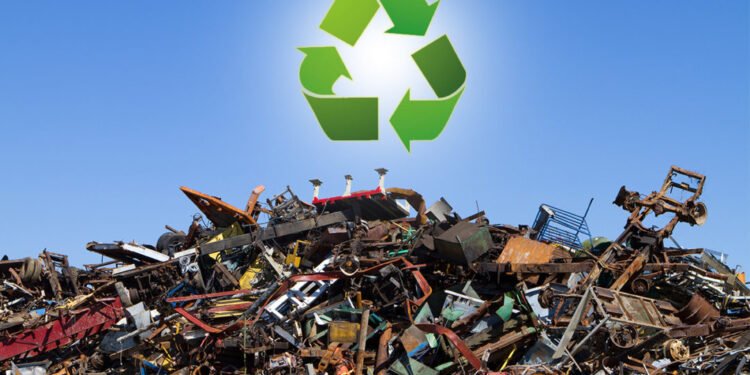Last Updated on March 13, 2024 by Flavia Calina
In a world increasingly focused on sustainability, scrap metal recycling stands out as a beacon of responsible stewardship of environmental and economic resources. This system has developed into a global powerhouse, preventing the squandering of invaluable raw materials and offering a more refined approach to industrial production. By connecting the dots between recycling electronics and more significant metal components, we can better understand the vital role scrap metal recycling plays in maintaining our planet’s health. This process conserves energy and materials and charters a path toward a circular economy where nothing is wasted and everything is valued.
Key Takeaways:
- Scrap metal recycling has vast environmental and economic benefits, conserving resources and energy.
- Technology is pivotal in evolving the metal recycling industry towards greater efficiency and scalability.
- Global policies, community involvement, and future innovations shape the trajectory of sustainable metal recycling.
The Journey of Scrap Metal
Metal’s recycling journey starts as discarded items—from household cans to industrial machinery. Collection centers and scrapyards become hives of activity where these disparate pieces converge. Here, a meticulously orchestrated process unfolds: metals are sorted, sheared, shredded, and, where necessary, melted. The sorted materials, now categorized by type and quality, are ready to be forged anew, often with a significantly lower carbon footprint than their mined counterparts. Technology and human expertise work in tandem to optimize the separation and preparation of scrap metal for its rebirth into new products.
Global Recycling Efforts and Policies
Scrap metal recycling is now a global initiative, with nations introducing policies and building infrastructures to handle waste more effectively. Some countries have made notable strides in enforcing legislation encouraging recycling, while others invest in technology to manage scrap metal better. The intricate tapestry of international relations also plays a role: trade agreements, environmental treaties, and economic partnerships shape the global recycling landscape. The cumulative effect of these efforts is an increasingly coordinated and efficient international recycling system.
Challenges Facing the Recycling Industry
Despite the strides made toward efficient scrap metal recycling, the industry grapples with challenges such as the cost of advanced technology, the logistics of collection and transportation, and the contamination of materials. Processing mixed or impure metals requires additional steps, reducing the cost-effectiveness of recycling programs. Economic pressures can discourage investment in new recycling technologies, potentially stalling progress. Addressing these challenges involves a mixture of innovation, education, and policy reform to ensure the continued growth and success of the recycling industry.
Environmental Benefits of Recycling Metal
Metal recycling is a robust defense against the depletion of the planet’s resources. It offers a reduction in energy consumption—often reaching a staggering 90% savings compared to the extraction of virgin materials—and a concomitant decrease in greenhouse gas emissions. By diverting metal waste from landfills, we help reduce leachate and methane emissions, thus mitigating pollution and protecting water quality. Moreover, metals reclamation eases the pressure on ecosystems, often jeopardized by mining activities. Complementing these ecological boons is a wealth of information from organizations such as the Environmental Protection Agency (EPA), whose research and advocacy illuminate the path toward a greener future.
Economic Advantages of Metal Recycling
Recycling metals is not just an environmental imperative; it’s economically wise. The recycling industry creates employment opportunities, ranging from manual labor to higher-level management and engineering roles. Recycled metals often fetch a competitive price in the market, influencing the bottom line of businesses that utilize these materials. By integrating recycled content into production processes, companies can bypass the volatility of commodity markets for virgin materials. This economically savvy approach buttresses sustainable business models and opens avenues for innovation in product development.
Different Types of Recyclable Metals
In the diverse universe of recyclable metals, ferrous metals—those containing iron—are ubiquitously recycled due to their magnetic properties, which facilitate easy separation. Nonferrous metals, including aluminum, copper, and brass, are sought for specific characteristics such as corrosion resistance and electrical conductivity. Despite the overall efficiency of the recycling process, challenges persist, such as the complexity of extracting metals from mixed or contaminated waste streams, which can compromise the quality and value of the end product.
Innovative Recycling Technologies
The recycling industry is at the forefront of technological innovation, implementing automated systems and cutting-edge techniques to improve metal separation and processing. Spectroscopy, X-ray technology, and infrared scanning are a few examples that exemplify the industry’s drive toward precision. Recycling facilities harnessing these technologies can handle higher volumes of scrap metal with increased accuracy, creating a more sustainable and profitable operation. As efficiency escalates, so does the capability of these plants to serve both local and international markets.
Community Involvement in Metal Recycling
The community’s support and participation are critical to the success of any recycling program. Public education initiatives can dispel myths about recycling and promote the correct separation of recyclables. Local efforts, such as school recycling drives and community clean-up events, engender a sense of collective responsibility and action. This proactive community participation helps to amplify the benefits of recycling, reinforcing a cultural norm that prioritizes sustainability and environmental consciousness.
Looking to the Future
The future of scrap metal recycling brims with potential, driven by the dual engines of innovation and commitment to ecological health. The industry anticipates a wave of novel materials and fresh technological breakthroughs that promise to renew and revitalize recycling processes. Organizations and individuals can actively shape an enduring environmental legacy by staying abreast of industry trends and investing in sustainable practices. Read more exciting articles on Today World Info











